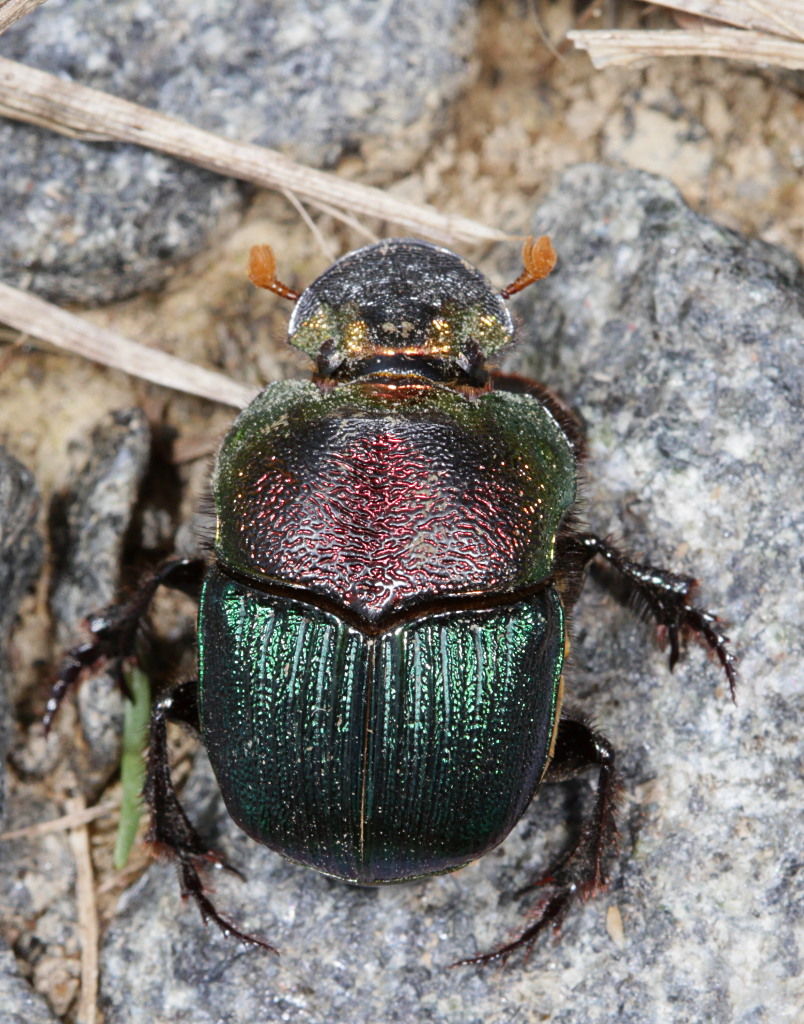Adaptation
The genus Phanaeus, and more specifically the species Phanaeus vindex or rainbow scarab beetle, comprise a group of aesthetically pleasing, metallic dung beetles (Price 2007). Although the family Scarabaeidae consists of numerous species sharing synapomorphic traits, the genus Phanaeus contains numerous qualities in terms of both form and function in which successfully distinguish itself from other genera of the same family (Price & May 2009). Members of the genus Phanaeus are all morphologically similar in terms of body size, all possessing a rather compact, heavy frame (Price & May 2009). For more knowledge of this species, visit P. vindex's page on the Encylopedia of Life. Also, despite the aforementioned potential hindrance related to their size, species found in the genus Phanaeus have been viewed to not only fly well and at an elevated rate, but with unexpected, unbelievable control (Price & May 2009). Since these decomposing beetles are particularly large and are able to fly rather swiftly in relation to their phenotypic traits, it would be deemed acceptable to believe the flight pattern of Phanaeus species to be quite abrupt. Aside from any misconceptions, constant periods of flight have been documented to reach several hours (Price & May 2009). For a closer look at another flying insect, click here!
 The discussion of the sensing and consequent reaction to the
environment can be separated into two commentaries:
reaction
to food and reaction to alternative stimuli; such as other beetles
(Price & May 2009).
In regards to the search and seizure of food, specifically dung,
phanaeines can be seen flying moderately close to the ground with
little to no turning until food has been detected (Price & May
2009). Of course detection most commonly refers to a visual
revelation of a food source; however P. vindex has evolutionarily
adopted an alternative detection method (Price & May 2009). The species P. vindex
uses its extensively well adapted sense of smell to respond to
threshold odor intensity of the targeted feces (Price & May 2009).
In comparison to other dung beetles, there are no phaneines known to
detect and eventually spot food while resting on some sort of
vegetation (Price & May 2009).
The discussion of the sensing and consequent reaction to the
environment can be separated into two commentaries:
reaction
to food and reaction to alternative stimuli; such as other beetles
(Price & May 2009).
In regards to the search and seizure of food, specifically dung,
phanaeines can be seen flying moderately close to the ground with
little to no turning until food has been detected (Price & May
2009). Of course detection most commonly refers to a visual
revelation of a food source; however P. vindex has evolutionarily
adopted an alternative detection method (Price & May 2009). The species P. vindex
uses its extensively well adapted sense of smell to respond to
threshold odor intensity of the targeted feces (Price & May 2009).
In comparison to other dung beetles, there are no phaneines known to
detect and eventually spot food while resting on some sort of
vegetation (Price & May 2009).
As previously stated, reaction to environmental stimuli could be separated into two areas. The second area that will be discussed is the response to alternative stimuli. As seen and commonly identified in the class Insecta are the antennae, which are commonly known to be used as receptors. Since Phanaeus vindex falls under the class Insecta, it too utilizes antennae (Campbell 2008). For more information on a different insect's use of antennae, click here. The antennae of the species P. vindex are the principle chemoreceptive organs exploited over long distances, however the maxillary palpi are found to be much more effective in terms of close range stimuli detection (Price & May 2009). In addition to the previous demonstration of stimuli response, perhaps a more concrete and relatable example is needed. A commonality of this species in regards to behavior is bisexual cooperation (Price 2009). Also, sexual dimorphism has been viewed as a noteworthy characteristic of P. vindex (Price 2007). Although this dimorphism leads to variable behavior between sexes, this species of dung beetle is responsive to the other sex’s actions (Price & May 2009). To exemplify this point, a phaneine will respond to the sight of a female pushing a dung fragment not only through a visual stimulus, but chemical stimuli such as the release of pheromones (Price & May 2009).
Feeling lost? Click here to go back Home! If not, continue on to Reproduction!
To see where we got our information, go to the References page!